Hardpoint
This articleneeds additional citations forverification.(March 2014) |


Ahardpointis an attachment location on astructural framedesigned to transferforceand carry an external or internalload.The term is usually used to refer to the mounting points (more formally known as aweapon stationorstation) on theairframeofmilitary aircraftthat carryweapons(e.g.gun podsandrocket pods),ordnances(bombsandmissiles) and support equipments (e.g.flaresandcountermeasures,targeting podsordrop tanks), and also include hardpoints (also known aspylons) on thewingsorfuselageof amilitary transport aircraft,commercial airlinerorprivate jetwhere externalturbofanjet enginesare often mounted.
Aircraft
[edit]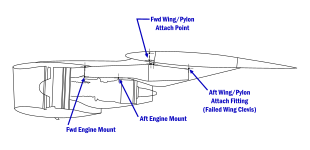
In aeronautics, the termstationis used to refer to a point of carriage on the frame of an aircraft. A station is usually rated to carry a certain amount ofpayload.It is a design number which already has taken the ratedg-forcesof the frame into account. Therefore, point loads on the structure from externally or internally mounted stores, engines, equipment, passengers, and payload are simply the weight of the item and any pylons, seats, mounting brackets, etc. multiplied by the maximum load factor which the aircraft will sustain when these items are carried.[1]
In civilian aviation a station is usually used to carry an external engine or a fuel tank. As engines are usually a fixed installation, operators usually refer to them with the designation of the engine. Therefore, the term is mostly being used for load points meant for non-fixed installation.
In the military, a station can also be calledweapons station.Unlike civilian aircraft, NATO aircraft frame strength is required to remain without detrimental deformations at 115 percent of the limit or specified loads, and without structural failure at ultimate loads.[2]Most stations on a military aircraft serve to carry pods or weapons. A minor number of stations can also serve to carry external fuel tanks. These stations are calledwet,a general aeronautic term referring to usage of fuel likewet thrust.The termwetis also carried over to the adapters, such as a pylon.
Wing stations require pylons to carry objects. Stations on the fuselage may not necessarily require a pylon, such as the fuselage stations on theMcDonnell Douglas F-15 Eagle,while other aircraft need pylons for certain stations in order to provide clearance for the landing gear retraction sequence (like inF-14 Tomcat) or to provide necessary item space (like inMikoyan MiG-27). While wing stations are usually of underwing design, some aircraft use hardpoints mounted on the top. For example,SEPECAT Jaguarhas had some versions fitted with overwing hardpoints for air-to-air missiles directly above the innermost wing pylons, instead of putting them on the wingtips.
Swing-wingaircraft that mount pylons on the moving portion of the wing (such as theGeneral Dynamics F-111and thePanavia Tornado) must include a mechanism for swiveling the pylon as the wing sweeps fore or aft, in order to keep the pylon and store facing directly forwards at all times. The F-111's outermost pair of hardpoints do not swivel, and can only be used while the wing is fully extended. This restricts the aircraft to subsonic flight only while these pylons are fitted, usually fitted with fuel tanks during ferry flights. The pylons are automatically jettisoned if the wing sweep moves past 26 degrees, which would mean that the aircraft is accelerating towardstransonicspeeds.
Stations may be numbered for reference or not at all (F-4 Phantom II). The numbering is not necessarily consistent and may originate from elsewhere like station 559 on theB-52.There is not necessarily an order in which numbers are assigned. The order can be for example from left to right (F/A-18 Hornet) or vice versa (F-15 Eagle), or mirrored and from outboard to inboard. The often unique centerline (CL) station is no exception.
Pylon
[edit]A pylon serves to connect the frame of an aircraft to an item or object that is being carried; hence, it is an adaptor.[3]The use of a pylon is necessary to clear the carriage item of control surfaces as well as prevent undesired disturbance of the flow of air toward the wing. Pylons are usually designed to be aerodynamic to reduce air resistance (drag). There are many different forms, sizes and designs of pylons distinctly termed accordingly like awedge adaptororstub wing pylon.
Stealth aircraft like theF-22orF-35can use jettisonable pylons to retain stealth and reduce drag.
While most pylons are part of a modular system which is compatible with numerous stores, certain weapons and aircraft can require special pylons or adapters to carry a specific load. For example, in theVietnam War,the "Wild Weasel"defense suppression version of theF-105 Thunderchief,the F-105G, could carry the usualAGM-45 "Shrike"anti-radiation missileon a standard pylon and launcher, but the newly developedAGM-78 Standard ARMrequired a specially designed and unique "LAU-78/a" launcher which was unique to that missile.
Military
[edit]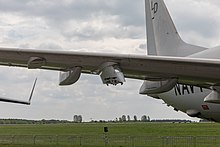
NATO suspension equipment (pylons and other means of carriage) and stores are standardized inMIL-STD-8591.A military pylon provides carriage, deployment, and the ability to jettison externalstores– weapons, pods,fuel tanksor otherordnance.Pylons have a modular bay to mount other adaptors and carry a wider variety of stores. These adaptors can bebomb racks,launchersor other types of support structures each with their own provisions for mounting all other assemblies.
Racks
[edit]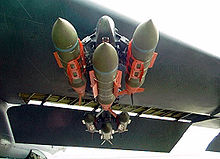
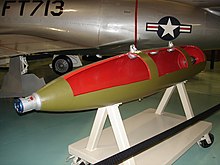

Racks carry, arm, and release stores. Racks are either part of, or can be inserted into, the modular bay of a support structure such as a pylon. A rack can mount a store or another piece of suspension equipment, for example, numerous bombs being mounted onto a single pylon, such as was done on F-105 Thunderchief missions over Vietnam, or the large external pylons on the B-52 Stratofortress, which can carry 12 unguided bombs in four triple ejector racks mounted to a single pylon. Alternatively, using the same pylon, but different racks and adapters, 9air-launched cruise missilescan be carried. Using modular racks and universal adapters makes it much easier to configure the desired load.
The store is mounted by locking the store's lugs with L-shaped suspension hooks in the rack. Depending on the mass of the store there can be a single lug or a number of lugs on the store separated by a certain distance. The distances are standardized. For NATO there is the 14-inch (360 mm) suspension for a lighter or 30-inch (760 mm) suspension for heavier stores. Depending on specific stores from 1,000 pounds (450 kg) upward, three or four lugs can be used within the defined suspension range.[2]For Russian stores there is the standard 110-millimetre (4.3 in) suspension for helicopters or the 250-millimetre (9.8 in) suspension.[4]To keep stores from rocking sideways as the aircraft maneuvers, sway braces are provided to steady the stores. Sway braces are bolted to the rack frame. These may be automatically or manually adjusted.
A rack can release a store via gravity or by ejection. Ejection uses an impulse cartridge,[5]a pyrotechnic device which provides jettison capability by igniting and supplying an ejection force to safely propel a store away from the rack and aircraft. Some racks contain an auxiliary cartridge in the event that the primary cartridges fail to fire. The rack will also have accessories such as azero retention force arming unit,asolenoidto pull arming wires from fuzes, ports for data, video or electrical fuzing. TheMIL-STD-1760aircraft/store electrical interconnection system defines a standardized electrical interface between a military aircraft and its carriage stores.
The term "rack" is also being used to refer to some support structures. In popular culture, "racks" usually refer to bomb racks or racks mounting bombs which covers everything from a support structure to its associated racks. A Multiple Ejector Rack (MER) usually refers to a support structure which enables the carriage of six stores. A Triple Ejector Rack (TER) refers to a support structure which enables the carriage of three stores.
Guided missile launchers
[edit]Guided missile launchers provide the mechanical and electrical means of suspending and air-launching a guided missile from an aircraft.[6]The housing assembly is the main structural member of the launcher. It is an extruded, machined aluminum member that provides structural rigidity to the launcher and includes provisions for mounting all other assemblies. It also includes provisions for mounting the launcher to the aircraft.
Some launchers (LAU-7/A)[1]have a nitrogen receiver assembly which stores the high-pressure nitrogen used to cool a missile's infrared detector in the guidance system. All receivers contain a charging valve (for refilling), relief valve, and a pressure indicator mounted in the aft end of the cylinder. Power is applied to the missile guidance control system through the umbilical plug. An actuator-operated safety device prevents inadvertent firing of launcher cartridges.
Missiles usehangersto mount to a rack which, in cross section, resemble either a T-bar called an internalT-shaped hangeror resemble a horseshoe called an externalU-shaped shoe.[2]Ambiguously, hangers are also often referred to as lugs or hooks. The majority of launchers can also be referred to asrail launchersbecause of the use of external rail flanges, a guide for the missile suspension hangers during firing.
Aircraft such as theF-4 Phantom II,theF-18,and thePanavia Tornado ADVhave semi-recessed fuselage stations to reduce drag. These stations have internally mounted launchers (LAU-116/A) that use ejection for launching. The rapidly expanding gases, created by impulse cartridges, actuate ejector pistons and release the missile from the launcher.[7]The missile is propelled to a safe distance before it ignites its rocket motor. Stealth aircraft such as the F-22 use extensible launchers that are pneumatically actuated and are either rail (LAU-141/A)[2]or ejector (LAU-142/A)[3]types. Stealth aircraft such as theChengdu J-20use retractable launchers which moves out on rails allowing the weapons bay to be closed while still hanging outside.
Rotary launcher
[edit]A rotary launcher is a rotating suspension equipment mounted inside thebomb bayof a bomber. Rotary launchers have stations of their own and offer the ability to select certain stores within the bomb bay for release. The disadvantage of a rotary launcher is a slow release of stores. The rotary launcher of theB-1for example requires seven seconds until the next store is rotated into release position.[8]
Bomb rack
[edit]In contrast to the rotary launcher, a conventional bomb rack of theB-52would have mounted stores in vertical columns making individual store selection and release impossible without releasing all stores ahead in the column line. The advantage of a conventional bomb rack is a prompt release of all stores in short order. Bombers like theB-52,theB-1or theB-2use custom designed bomb rack support structures with their own designation e.g. Common Bomb Rack (CBR), Common Bomb Module (CBM), or Smart Bomb Rack Assembly (SBRA).
Store release control
[edit]Aside from the release options of a rack a pilot can select release mode for releasing one or multiple stores. Stores can be jettisoned selectively in single mode orripple modeorsalvo mode.The termrippleapplies to the single- or ripple and single- continuous release mode from one or from mirror stations. Salvo release mode applies to a combination of several stations together e.g. adjacent stations. For multiple store release an interval timer can be set to release stores in fixed time steps. For an external store emergency release, there is for example anemergency jettison buttonin theF-4 Phantom II,a feature found on all naval aircraft in case an engine or catapult fails during launch; in such cases, a pilot can press the "panic button", and jettison all stores, reducing weight and hopefully allowing the aircraft to avoid hitting the sea, and to climb away to decide on further action. Land-based aircraft often have a similar feature, for similar reasons, although the situation is generally not quite as critical as a failure during a catapult launch.
Example station designation
[edit]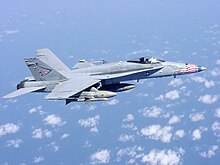
TheBoeingF/A-18A/B/C/Dfamily has nine weapons stations:
- 1 & 9,at the wingtips, have a single rail launcher for an AIM-9 type store.
- 2, 3, 7, & 8,located under the left and right wings, have mounting points for SUU-63A or SUU-63A/A pylons. The pylons in turn support a BRU-32/A ejector rack, to which various stores or launchers are attached. These stations may have a bomb loaded directly upon them, or have a multiple-ejector rack with several stores, or various rail-type launchers for air-to-air and air-to-ground missiles:
- A LAU-115 rail-type launcher for anAIM-7;[4]
- A LAU-115 with two LAU-7 orLAU-127launchers, one bolted to either side, for twoAIM-9orAIM-120s;[5]
- A LAU-117 for anAGM-65Maverick;[6]
- A LAU-118 for anAGM-88HARM[7]
- 4 & 6,which are located on the sides of the fuselage, are LAU-116 ejector-type launchers for AIM-7 and AIM-120 missiles. Station 4 can also support a Forward-Looking Infrared (FLIR) pod for detecting and marking targets.
- 5,which is on the centerline underneath the fuselage, mounts a smaller SUU-62/A pylon and a BRU-32 rack, and many of the same stores as the wing pylons. The exception is anything rocket-powered, to avoid endangering the nose landing gear.[citation needed]
- 3, 5, & 7,are 'wet' feed fuel to and from external fuel tanks.
See also
[edit]References
[edit]- ^Robert Hooke (2004).Introduction to Aeronautics: A Design Perspective.AIAA.ISBN9781600860720.Retrieved16 March2014.Chapter 7
- ^abcAirborne Stores, Suspension Equipment and Aircraft-store interface (carriage phase)Archived15 December 2017 at theWayback MachineMIL-STD-8591, 12 December 2005
- ^"The Weapons File"[permanent dead link]Air Armament Center
- ^Jane's Russian Air Launched Weapons
- ^Impulse and Delay CartridgesAirman – Aviation theories and other practices
- ^Guided Missile LaunchersAviation Ordinanceman – Aviation theories and other practices
- ^Patent US 8353237
- ^"The B-1B Bomber and Options for enhancements"Archived14 April 2013 at theWayback MachineCongressional Budget Office, August, 1988
